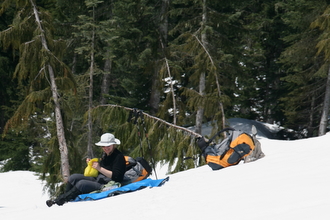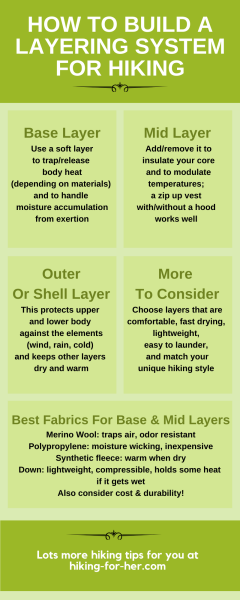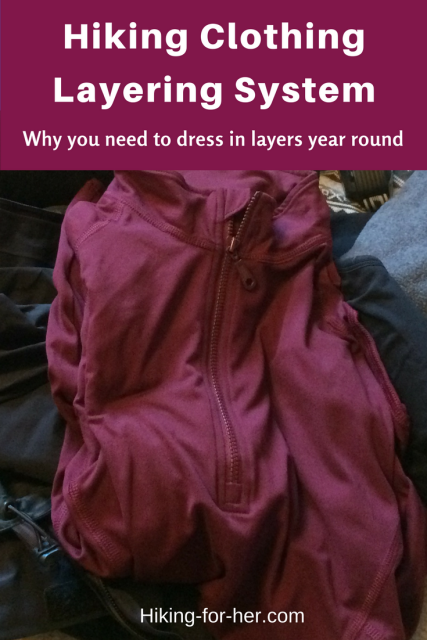
Hiking Clothing Layering System:
Why You Need One
And How To Get It
By Diane Spicer
A women's hiking clothing layering system will save you time, make you as comfortable as possible in challenging trail conditions, and will keep you safe when you have to stay out overnight on an unplanned bivouac.
That's why dressing in layers on a hike makes sense year round!
Let's look at what a hiking clothing layering system is designed to accomplish.
Then we'll turn to getting your layers up to speed, so you can tackle any trail conditions you encounter and stay comfortable while hiking.
Just starting out as a beginner hiker? Read what to wear hiking first.
Why bother with a hiking clothing layering system?
In my experience, there are two general categories of hikers:
- Prepared
- Unprepared
Because you're investing time in reading this article on clothes layers for hikers, I already know which category you are in, or are striving to join.
So let's quickly outline the benefits of wearing hiking clothing that you put on, remove, adjust and always have handy in your backpack regardless of the weather.
Benefits of hiking clothing layers, in a nutshell:
- Keep you warm or cool to your comfort levels
- Keep you dry when it's not dry around you
- Keep you protected from weather and terrain
- Keep you confident about your ability to handle an unplanned or dicey situation
- Allow you to respond to an impromptu invitation to have lunch on a snow field

Define this layering system, please!
In my 45+ years of trail experience, a layering system consists of three essential layers:
- Inner or base layer of clothing to trap or release warmth (depending on materials) and to handle moisture accumulation
- Mid layer(s) to insulate and modulate temperatures
- Outer layer to protect against the elements and keep other layers dry and warm
Makes sense, right?
Each layer contributes to the "big 3" components of hiking comfort and safety:
- Thermoregulation, to adjust to temperature swings or extremes
- Moisture wicking, to keep skin as dry and blister/chafe free as possible
- Protection against abrasion, wind, dessication, deluges and hypothermia
But your search for the best hiking clothing layering system goes further than this.
Also think about clothing which:
- is soft and comfortable
- is lightweight and easy to pack into your backpack
- moves easily with your body as you bend, twist, and stride
- allows odors to be removed easily with soap (especially if hanging overnight in your tent)
- is easy to put on and also easy to remove when it's damp with sweat or rigid with cold
Build a hiking clothing layering system from the skin out
Let's go back through those 3 layers again for a closer look at how to dress in layers on a hiking trail.
You might need a few tips on what to think about as you size up each layer, and Hiking For Her is here to deliver them.
And don't feel that you have to get this system right, or complete, in just a few days. It will take time to figure out what works well for your style of hiking.
Inner or base layer
The inner layer for hikers is a moisture management layer.
That relies on specific fabrics labelled for their moisture wicking ability.
Resist the urge to put on every day or bargain bin clothing and hit the trail.
- Cotton does not do the job except in ideal summer conditions (dry and warm).
- Purchase clothing specifically made for hiking or some other athletic activity, because those fabrics will stand up to your sweat.
- Don't forget that you'll sweat on cold weather hikes and during snowshoeing, so you'll want a moisture wicking inner layer next to your skin.
If you're up against really cold conditions, you'll want long underwear, both top and bottom.
Details on handling cold weather hikes are here.
And you might want these snowshoeing tips, too.
For women hikers, the inner layer of clothing starts with a sports bra (recommended regardless of the generosity of your endowment, to prevent chafing), undies, and sometimes a warm sleeveless shirt (tank top) if you know you'll be wearing more layers.
Or a wicking, light weight tank top might become your mid layer in warm weather.
I also consider two layered pair of hiking socks an important base layer for hikers.
Mid layer in your layering system
Here's where your clothing becomes optional and customized.
Only you know your comfort range and tolerance for temperature swings and moisture levels.
So build in some customization in your mid layer.
Clothing for your upper torso's mid layer can include:
- a hiking vest
- a shirt with the sleeve length appropriate to conditions
- hiking shorts or pants
- hiking skirt with or without leggings
Suggestions for hiking mid layer choices:
- Choose fabrics that stand up to abrasion, dirt, moisture and frequent handling.
- The less fussiness the better: few or no buttons, lightweight plastic zippers that don't jam, no extra embroidery or doodads that can unravel, fall off or catch on branches.
- Don't
choose bulky clothing for your mid layer, because you'll feel like a
stuffed sausage and won't be able to move around in comfort once you add your outer layer.
In cold weather, you can add a scarf around your neck that tucks beneath your outer layer. This is one of the most versatile pieces of hiking clothing you can own, because it can cover your head and ears as well as your neck.
And it's so easy to toss into your backpack when you don't need it!
Outer layer in your hiking clothing layering system
For safety's sake, it's important to carry enough layers to meet the demands of changing weather and the daily cycle of temperature wherever you are hiking.
One of the biggest mistakes I see beginner hikers make is to underestimate how much clothing they need to carry.
If I had a dollar for every shivering, miserable hiker I met on the trail, I'd take you out for a really fabulous dinner - on my private jet winging its way to Paris.
But alas, I can only offer these humble tips on choosing hiking clothing that layers over your other 2 layers:
- Jackets
- Hats
- Gloves
- Rain gear
Now for a few words about your choices for each item in your outer layers.
Hiking jackets
A jacket for a hiker means many things, but most importantly it means protection.
Mother Nature will throw all kinds of fun your way: wind, sun, water in all of its 3 forms, insects, heat, cold...
And one jacket just isn't going to cut it (see the list above for what "it" might be, and all within one 24 hour period).
Here are my tips on choosing hiking jackets. You can begin to build up a small repertoire of the best jackets for the type of hiking you do, by making some wise buying decisions based on my decades of trail experience.
Hiking hats
Just as for jackets, you're going to need a selection of hiking hats that suit your hiking style.
On my backpacking trips, I carry at least 3 or 4 different hats.
They're lightweight, packable, and have literally saved my life when the skies open up and dump onto my head or I'm crossing shade-less terrain.
Start your hiking hat collection here.
Hiking gloves
I can't say enough good things about carrying a pair of gloves on every hike.
If you don't need them to keep warm, you might need them to pick up something spiny or sharp.
Always have a pair of gloves stashed in your backpack! (Thank me later.)
Just be sure they're lightweight, dry quickly, and are replaced when the fingertips get too thin.
As with hats, I'm a bit of a glove collector. Read my tips for picking a pair right here.
Rain gear for hikers - so important!
A classic mistake is to forget your rain gear because the sun is shining brightly before you reach the trail head.
Mother Nature loves to mess with us hikers, and one of her favorite ways is to gather some thunder clouds later in the day and watch us shiver.
So don't neglect to carry your rain gear, using these tips.
Recommendations for specific clothing in each layer
I only wear what works well in a hiking clothing layering system, and what works is what I've tested while hiking thousands of miles in all kinds of conditions.
- My top picks for women's athletic clothing for hiking
- Lots of tips for choosing great hiking clothes
- Use sun protective clothing in summer conditions
Here's the hiking clothing layering system, summarized
 Enjoy this hiking infographic which gives you all the Hiking For Her details on how to build your layering system.
Enjoy this hiking infographic which gives you all the Hiking For Her details on how to build your layering system.
Now layer up and hit the trail!
Now you know why you need to dress in layers while hiking.
And you know how to build a hiking clothing layering system.
Happy Layered Trails!
Home page > Best Hiking Tips >
Best Hiking Clothing Layering System
|
I get emails all the time about what I wear, eat, carry and love to use on the trail. That's
why I provide affiliate links to you: the best gear that I use myself and have seen used by other hikers is instantly
available for your consideration, and the gear company sends a few
pennies per dollar to this reader-supported hiking website. There is no added cost to you! Everyone ends up a winner: Great gear for you, strong gear companies, and more free hiking tips for everyone. Thanks very much for your support. It's warmly and sincerely appreciated. It also helps send these hiking tips to all your virtual trail buddies around the globe. |
 |


